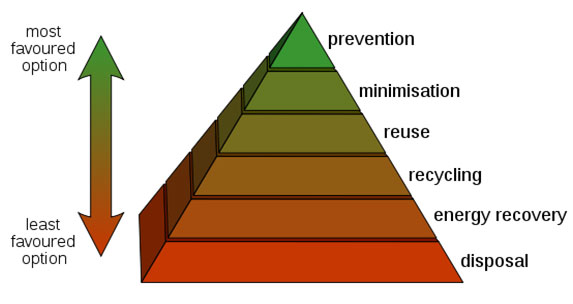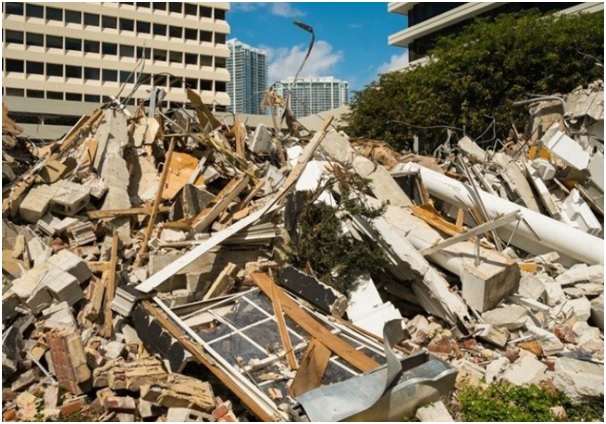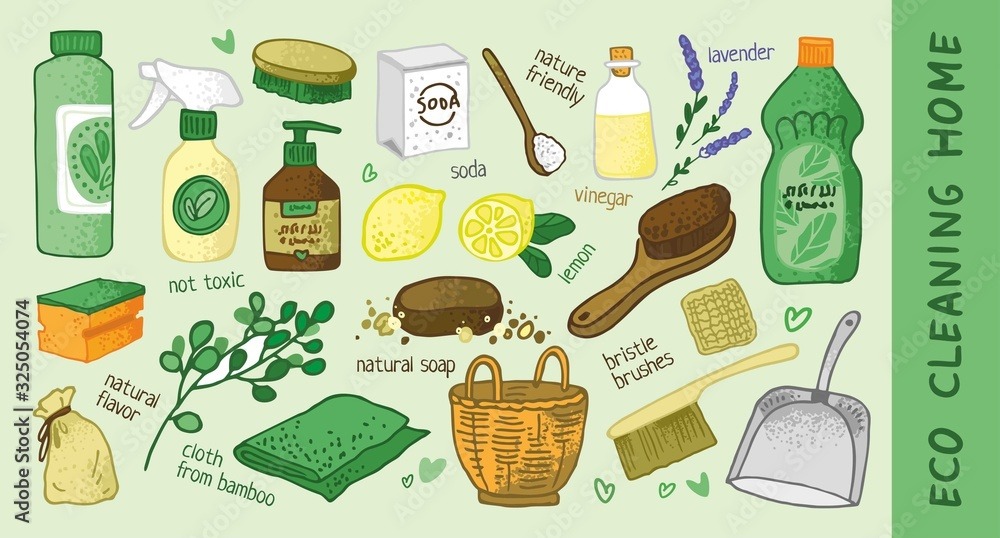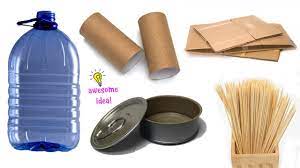Courtesy : www.constrofacilitator.com
green Reuse of materials
The building industry has not only become a major consumer of materials it has also become a source of pollution. Environmental integrated production and reusing and recycling is of great importance that shall ensure that the technical, environmental and economic feasibility of alternative systems is considered and is taken into account before construction starts. The article focuses on Reuse Building Materials as a way for environment protection and sustainable development.
Integrated environmental management integrates the requirements of sustainable development and LCA. There are many methods used to reduce waste and increase profits through salvage, reuse, and the recycling of construction waste. Sustainable development as a tool to continual improvement cycle and with processes innovation the need to save money in the processes via reduced resources and utility costs. This article demonstrates that alternatives to modern building materials are available.
Introduction
All systems recycle the biosphere is a network of continually recycling materials and information in alternating cycles of convergence and divergence. As materials converge or become more concentrated they gain in quality, increasing their potential to drive useful work in proportion to their concentrations relative to the environment. As their potentials are used, materials diverge or become more dispersed in the landscape, only to be concentrated again at another time and place. Fitting the patterns of humanity to these material cycling pathways has become paramount in importance as our numbers and influence on the biosphere increases.
The energy performance of buildings (the EPBD) requires several different measures to achieve prudent and rational use of energy resources and to reduce the environmental impact of the energy use for buildings. This is to be accomplished by increased energy efficiency in both new and existing buildings. A basic requirement for measures is the existence of a general framework for a methodology of calculation of the total energy performance of buildings.
Environmental Management and Strategies for Building Material Reuse and Recycle in Buildings
Leaders of successful, high-growth companies understand that innovation is what drives growth, and innovation is achieved by awesome people with a shared relentless growth attitude and shared passion for problem solving and for turning ideas into realities. Companies that continuously innovate will create and re-invent new markets, products, services, and business models – which lead to more growth. Innovation is founded on your enterprise’s ability to recognize market opportunities, your internal capabilities to respond innovatively, and your knowledge base. So, the best thing to do to guarantee growth is to build a sustainable innovation organization around the following components:
- Vision and strategy for innovation
- Culture supporting innovation
- Processes, practices and systems supporting innovation
- Top management team leading innovation
- Cross-functional teams mapping innovation road
- Empowered employees driving innovation.
Reuse and recycling of building material is a growing area of interest and concern in many parts of the country. Current practices and trends in the building material waste management area are examined from a building life cycle standpoint or cradle to reincarnation concept.
Strategies include zero waste, integrated recycling, international approaches, and reuse of materials, resource optimisation, waste reduction, and deconstruction. Examination of the waste management hierarchy and life cycle management of material is used to improve the understanding of reuse and recycle opportunities. Other considerations include cost, economic factors, social factors and environmental factors. All of these assessments are needed to develop a comprehensive waste management plan for a specific project.
It is important to recognize that the sustained growth in reuse efforts, as well as the sustained interest of the reuse industry, derives in large measure from the solid waste reduction hierarchy: Reduce, Reuse, and then recycle. It is best to reduce first, reuse as a second option, then to resort to recycling. Reuse is recognized as being distinct from recycling, both in doctrine, and in the handling of the materials this unique industry diverts from the waste stream. Recyclers have successfully kept materials out of the landfill by collecting, segregating, processing and manufacturing their collected goods into new products.

Why does reuse and recycling of building materials matter?
If you think about the sheer volume of material used throughout the building process, recycling building components makes logical sense. Reusing materials:
- Reduces the demand for new resources
- Cuts costs related to the production and transportation of new materials and
- Eliminates the need to send waste to landfill sites
Benefits of Reuse and Recycle
A. Environmental Benefits
Many reuse programs have evolved from local solid waste reduction goals because reuse requires fewer resources, less energy, and less labour, compared to recycling, disposal, or the manufacture of new products from virgin materials. Reuse provides an excellent, environmentally-preferred alternative to other waste management methods, because it reduces air, water and land pollution, limits the need for new natural resources, such as timber, petroleum, fibres and other materials.
B. Community Benefits
For many years, reuse has been used as a critical way of getting needed materials to the many disadvantaged populations that exist. Reuse continues to provide an excellent way in which to get people the food, clothing, building materials, business equipment, medical supplies and other items that they desperately need. There are other ways, however, that reuse benefits the community. Many reuse centres are engaged in job-training programs, programs for the handicapped or at-risk youth programs.
C. Economic Benefits
When reusing materials, instead of creating new products from virgin materials, there are fewer burdens on the economy. Reuse is an economical way for people of all socio-economic circles to acquire the items they need.
Different Approaches for Reuse and Recycle of Building Materials
Green Building
Sustainable design and construction, or “green building,” is a holistic approach that minimizes environmental impact, reduces maintenance, and creates a more desirable workspace for the building occupants. Green building focuses on siting issues, energy and water efficiency, recycled content building materials, minimizing local and global environmental effects caused by buildings, and indoor environmental quality. The goal is to transform the market of public funded construction, so that all projects will be designed and constructed reflecting green building principles. The requirements include;
- General framework for a methodology of calculation of the integrated performance of buildings.
- Setting of minimum energy standards in new and existing buildings.
- Energy certification of buildings
- Inspection and assessment of heating and cooling installations.
Buildings will have an impact on long-term energy consumption and new buildings should therefore meet minimum energy performance requirements tailored to the local climate. Best practice should in this respect be geared to the optimum use of factors relevant to enhancing energy performance. As the application of alternative energy supply systems is generally not explored to its full potential, the technical, environmental and economic feasibility of alternative energy supply systems should be considered; this can be carried out once, by the Member State, through a study which produces a list of energy conservation measures, for average local market conditions, meeting cost-effectiveness criteria. Before construction starts, specific studies may be requested if the measure, or measures, is deemed feasible. Incorporating reusable/recyclable/biodegradable building materials in your project can reduce waste, pollution, and energy use. Some examples of reusable / recyclable/ biodegradable building materials include:Earthen Materials (reusable/biodegradable)
Steel, Aluminium, Iron, Copper (reusable/recyclable)
Bricks (reusable/recyclable)
Concrete (may be crushed and recycled)
Gypsum/Drywall (recyclable, sometimes biodegradable)
Straw Bale Insulation (biodegradable)
Wool Carpet (biodegradable)
Linoleum Flooring (biodegradable)
Building materials composed of one substance (e.g., steel, concrete, wood, etc.), or that are readily disassembled into individual materials, are generally easiest to reuse or recycle. Materials composed of many ingredients, such as vinyl siding or wood chipboard are generally not readily reusable, recyclable, or biodegradable. Evaluate materials carefully. Are they the best choice for the application? Are they durable? Can they be readily disassembled for reuse, recycling, or degrading at the end of the useful life of the building?
The extraction, manufacture and transport, and disposal of virgin building materials pollute air and water, depletes resources, and damages natural habitats. Construction and demolition are responsible for roughly 30% of the solid waste stream and real-world case studies by Waste Management Authorities across the globe have demonstrated more than 85% of that material, from flooring to roofing to packaging, is reusable or recyclable.
Minimize Construction Waste Impacts
The following considerations can minimize waste impacts on any size project. From the broad influences of design to the specific methods used on the job-site, all play a role in the prevention of waste.
- Design to Prevent Waste. Design with standard sizes for building materials. Specify materials and assemblies that can be easily disassembled at the end of their useful life. Design precast concrete members for concrete (Tilt- up) construction. Choose durable non-toxic interior finishes or materials. Design spaces to be flexible for changing uses. Consider reusing materials (on-site) or installing salvaged materials from off-site sources.
- Plan for Waste Prevention. Target specific waste producing practices for waste prevention. Include waste prevention measures in a Waste Management Plan. Communicate your waste management plan at meetings, post it on-line, and promote the result.
- Use Construction Methods that Prevent Waste. For wood construction, use advanced framing techniques (e.g. 24″ on-centre, and insulated headers), trusses for roof or floor framing; finger- jointed studs and trim, and engineered wood products. Consider using wood frame wall panels prefabricated off-site.
- Practice Job-Site Waste Prevention Methods. Set up central cutting areas for wood and other materials. Reuse concrete forms or choose reusable metal or fiberglass forms. Clearly mark areas key to waste prevention, such as the material storage, central cutting, and recycling stations. Practice material storage and handling procedures to prevent loss or damage.
- Purchase to Prevent Waste. Purchase salvaged, recycled, or recycled-content materials and equipment. Check to ensure the correct amount of each material is delivered to the site. Maintain an up-to-date material ordering and delivery schedule to minimize the amount of time that materials are on-site and reduce the chance of damage. Replace toxic materials with less toxic or non-toxic products to reduce hazardous packaging. Choose products with minimal or no packaging. Ask suppliers to deliver supplies using sturdy, returnable pallets and containers. Have suppliers pick up pallets and empty containers. Require suppliers to take back or buy-back substandard, rejected, or unused items.

Tips to recognize Construction Waste Reduction:
- Walk through your local used building materials store to see what they carry and accept.
- Plan Ahead. Make a waste reduction or recycling plan before starting work, and communicate it to all parties. Create a system of where things go so you handle materials as little as possible to save labour.
- Remove salvage items early in the process.
- Re-use scrap on the job. Use one centralized wood-cutting station to promote reuse.
- Look for materials on the materials exchanges (VBMX, NH Materials Exchange).
- Use standard dimensions to reduce cut-off waste.
- Get a grant from the State to create your own innovative project.
Resource Efficiency can be accomplished by utilizing materials that meet the following criteria:
- Recycled Content: Products with identifiable recycled content, including post-industrial content with a preference for postconsumer content.
- Natural, plentiful or renewable: Materials harvested from sustainably managed sources and preferably have an independent certification (e.g., certified wood) and are certified by an independent third party.
- Resource efficient manufacturing process: Products manufactured with resource-efficient processes including reducing energy consumption, minimizing waste (recycled, recyclable and or source reduced product packaging), and reducing greenhouse gases.
- Locally available: Building materials, components, and systems found locally or regionally saving energy and resources in transportation to the project site.
- Salvaged, refurbished, or remanufactured: Includes saving a material from disposal and renovating, repairing, restoring, or generally improving the appearance, performance, quality, functionality, or value of a product.
- Reusable or recyclable: Select materials that can be easily dismantled and reused or recycled at the end of their useful life.
- Recycled or recyclable product packaging: Products enclosed in recycled content or recyclable packaging.
- Durable: Materials that are longer lasting or are comparable to conventional products with long life expectancies.
Product selection can begin after the establishment of project-specific environmental goals. The environmental assessment process for building products involves three basic steps:
- Research: This step involves gathering all technical information to be evaluated, including manufacturers’ information such as Material Safety Data Sheets (MSDS), Indoor Air Quality (IAQ) test data, product warranties, source material characteristics, recycled content data, environmental statements, and durability information. In addition, this step may involve researching other environmental issues, building codes, government regulations, building industry articles, model green building product specifications, and other sources of product data. Research helps identify the full range of the project’s building material options.
- Evaluation: This step involves confirmation of the technical information, as well as filling in information gaps. For example, the evaluator may request product certifications from manufacturers to help sort out possible exaggerated environmental product claims. Evaluation and assessment is relatively simple when comparing similar types of building materials using the environmental criteria. For example, a recycled content assessment between various manufacturers of medium density fibreboard is a relatively straightforward “apples to apples” comparison. However, the evaluation process is more complex when comparing different products with the same function. Then it may become necessary to process both descriptive and quantitative forms of data. A life cycle assessment (LCA) is an evaluation of the relative “greenness” of building materials and products. LCA addresses the impacts of a product through all of its life stages. Although rather simple in principle, this approach has been difficult and expensive in actual practice (although that appears to be changing). One tool that uses the LCA methodology is BEES (Building for Environmental and Economic Sustainability) software. It allows users to balance the environmental and economic performance of building products. The software was developed by the National Institute of Standards and Technology’s Building and Fire Research Laboratory.
- Selection: This step often involves the use of an evaluation matrix for scoring the project-specific environmental criteria. The total score of each product evaluation will indicate the product with the highest environmental attributes. Individual criteria included in the rating system can be weighted to accommodate project-specific goals and objectives.
Reuse Lightweight Concrete
The process of reusing and recycling begins by product design and development. Some of these benefits may include: lower costs, stimulation of innovation, new business opportunities, and improved product quality.
Things to check for reuse of lightweight concrete
- Types of concrete and rubble accepted.
- Size of concrete pieces.
- Amount of preprocessing.
- Acceptable levels of bricks and tiles.
- Acceptable amount of contamination from materials such as glass, metal, soil.
A granulated porous recycled waste glass (RWG), namely Poraver, derived from the differential separation of municipal solid waste, is being used as aggregate in concrete formulations. The use of this type of glass can improve thermal insulation in addition to demonstrating good mechanical properties. Waste plastic lightweight aggregate (WPLA) produced from polyethylene terephthalate (PET) with granulated blast-furnace slag (GBFS) and river sand aggregate is also a good option. These are just two examples of different types of lightweight concrete being adopted for sustainable purposes.





